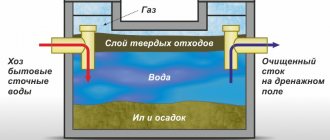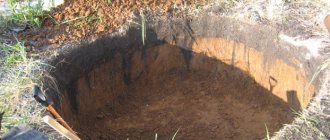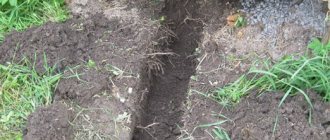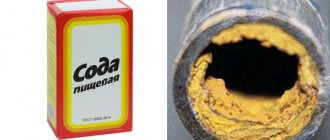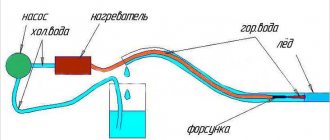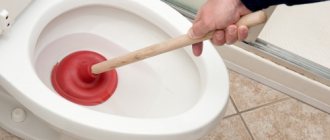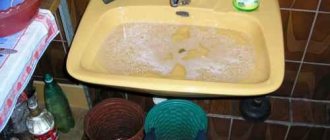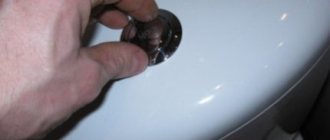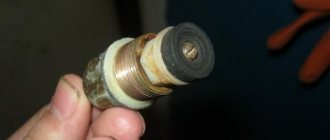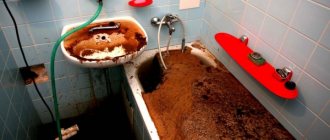Owners of private houses are especially concerned about the question “What to do if the cesspool quickly fills up and freezes in the winter?”
Causes of cesspool overflow
It is immediately worth noting that there are two types of cesspools - those that have an open bottom, and those that have a closed bottom (shambo). In the first case, the wastewater will go into the soil, and the second type, which according to building regulations is called a “septic tank”, is cleaned using a sewer truck. According to any sanitary standard, the use of an open cesspool or drainage pit is strictly prohibited due to the high environmental threat to soil and groundwater.
If the owner of a summer cottage decides to install an individual water supply system from a well or borehole on the territory and uses an open type of cesspool, then first of all he will put the health of his loved ones and his own at risk. By the way, water contaminated by sewage effluent can even infect the entire village if water is drawn from one water basin. Despite the legislation, open cesspools are widely used in rural areas, in urban areas and country houses, if there is no sewerage system, but they have a centralized water supply. Because of this, temporary cesspools are often installed during the construction and construction of one’s own home.
During operation, the drainage pit begins to fill quickly for the following reasons:
- A small volume, which is simply not designed to accommodate the increased amount of sewage and wastewater for various reasons, and because of this begins to overflow, for the same reason an environmentally safe and sealed storage tank in the form of a septic tank can overflow.
can also lead to a cesspool quickly filling up on the site. When the snow melts in the spring and there is a large amount of precipitation, the soil begins to become saturated with moisture, which over time enters the sewer pit and fills it with water. This can lead to overflow, even if there is no sewage drain in the pit at all.
Increased groundwater level- Siltation of the walls and bottom can lead to the formation of a dense crust, which will prevent all liquid from escaping into the ground.
- Fat deposits are quite often the reason that the water repellent film begins to prevent the absorption of liquid by the bottom and walls, which is why the pit also begins to overflow.
- Freezing of the soil can lead to the fact that wastewater not only goes into the ground, but also freezes, and because of this, an ice crust forms on the surface, which prevents the drainage tank from filling.
- Unsuitable soil with a high clay content will also prevent water from being absorbed into the ground and the hole will begin to overflow too quickly and often.
Once you have figured out the reasons why the cesspool is filling up quickly, you can move on to ways to solve the problem.
Reasons for fast filling
Problems of this type with a cesspool can occur in the following cases:
- discrepancies between its volume and the amount of incoming wastewater;
- silting of the bottom;
- the appearance of fatty deposits on the walls, preventing normal drainage.
In the cold season, among other things, there may be an appearance of overflow due to freezing of the wastewater in the collector. Regular cesspool care, including in winter, is a mandatory procedure. If the collector is already full, urgent measures need to be taken. Indeed, in this case, not only does the sewage system stop working normally, but also an extremely unpleasant odor appears, which also disturbs the neighbors.
Methods for dealing with drain overflow
If the pit is filled to the brim, then the wastewater will begin to flow out and spread over the surface of the site as a whole, and such a negative moment will begin to pollute the soil and spread unpleasant aromas, therefore, to combat a local environmental disaster on the site, the following methods are used.
Vacuum truck
Calling a sewer truck is often the best option, and before taking any action, you will first need to clear the hole of sewerage. When pumping out, you should remove as much silt as possible that covers the bottom and walls, and during the pumping process you can take a hose, and then, under high pressure of water, wash away the layers of fat and silt from the bottom and walls. If the bottom sediments have a very dense structure, then you should arm yourself with a metal tube or another hard and long pole, and then try to stir up and soften the mass that has settled to the bottom, which in the future, when mixed with water, will be easily pumped out using a pump.
If you have the opportunity to negotiate with the driver, and also have extra time, then after pumping out the sewage, fill the hole again, but this time with clean water (to speed up the process, use previously prepared barrels of water) and perform pumping again.
Mechanical cleaning
Mechanical cleansing is a folk remedy and is used after the pit has been emptied by a sewer machine, and will also allow you to get rid of fat and silt deposits that have been deeply absorbed into the bottom and side walls for a long time. To do this, you will need to lower a vessel with a shovel into the hole, remove soil from the walls, remove it from the bottom, lift it to the surface with buckets and dispose of it far beyond the territory of the summer cottage. Racking out will not take much time and effort, but in terms of its effectiveness, the method is better than all chemical and biological methods of cleansing, moreover, you will not need to spend additional money, and if you do not want to do all the work yourself, you can always find an assistant who will be ready to do similar work for little remuneration.
Please note that the mechanical method is probably the only option for dealing with the overflow of a sewage pit in soil with clay, and in this case it should be deepened with a shovel until the end of the clay layer, and you should also make several channels with a factory or homemade drill in the bottom for ideal drainage.
To reduce the amount of fat deposits in the pit when filling, which reduces its effectiveness, you can use special grease filters that are installed in the kitchen drain and collect excess fat.
Chemicals
Household chemicals are a fairly effective and modern assistant in the fight against the problem when a cesspool quickly fills up, and the industry produces several types of drugs with different chemical compositions for cleaning open-type septic tanks.
- Liquid formaldehyde ( formalin) is extremely effective and inexpensive to use, but due to its high level of toxicity, which is associated with carcinogenicity, it is not recommended for use by sanitation services. Formalin can be used as a substance that will disinfect, destroy all living bacteria and stop the decomposition processes inside the cesspool, which can even release toxic gases.
- Lime bleach is known to everyone for its ability to disinfect and its low cost, but it should be used with extreme caution and away from a residential building - it is carcinogenic and toxic. When pouring into a hole, it must be covered - in daylight, lime very quickly begins to lose active chlorine, which ensures its effectiveness in interacting with organic bacteria.
Nitrate oxidizers, which are ways to dissolve sludge inside a cesspool and dilute any biological waste, cannot react to aggressive chemicals, are environmentally friendly, but are much more expensive than similar chemicals. When fecal waste is decomposed by nitrates, the unpleasant aroma is eliminated, and the contents of the pit become homogeneous, and the resulting mass can be used as fertilizer. For these purposes, a drug that contains nitrogen-containing acids is best suited. The disadvantage of nitrate cleaners is the negative impact on iron, which leads to deposits appearing on them and the passage channel of steel pipes becoming overgrown, and when using fecal electric pumps, there is a possibility of damage to their metal parts.
- Ammonium salt cleaners containing tetravalent active nitrogen effectively dissolve organic matter, and under the influence of water it turns into a standard alkaline solution with high concentration. The drugs work well with fecal matter and can lose effectiveness if they are in an environment where there is chlorine, household chemicals and detergents. Along with the decomposition of fecal matter, ammonium salt purifiers are ways to remove odors, while fumes negatively affect human health and also pollute the natural environment, and for this reason, pits during use are located no closer than 20 meters from the house, and emptying must be carried out using a vacuum method.
Please note that none of the chemicals will be able to remove wastewater, and their main purpose will be to liquefy viscous and even solid waste, which in the future can be pumped out more efficiently using a sewer truck, and eliminate unpleasant odors. This will also help disinfect everything inside and prevent the appearance of larvae and insects during the warm season.
Biological drugs
The cleaning method for storage septic tanks and pits using bacteria if the water from the cesspool has stopped draining is called bacterial-enzymatic, and two types of bacteria can be used:
- Aerobic. Colonies begin to develop if they have good access to oxygen, which is pumped into the purification system using compressors, while anaerobes that feed on incoming organic matter will process everything with a high degree of efficiency into a mass of useful substances for fertilizer and clarify the water.
- Anaerobic. They help clean storage containers without access to oxygen, methods to process organic matter within 2-3 days with lower efficiency than aerobes, but are ideal for cesspools, since there is no air in them.
Among the advantages of bacterial cleaning methods, the following are worth highlighting:
- As a result of processing, you get safe sludge, which is a valuable fertilizer, and when it is raised to the surface and further used, you can not only improve the soil on the site, but even save on the costs of pumping wastewater using a sewage truck, and this will reduce the number of her calls.
Biological preparations are quite safe for human health even with direct contact, help eliminate unpleasant odors and excessive gas formation, and during operation they decompose waste with the release of water and carbon dioxide.- Neutral to all types of building materials.
- They are able to reproduce at temperatures from +3 to +32 degrees, so in winter at subzero temperatures it will not be possible to clean a cesspool or septic tank with them.
- They are sensitive to household chemicals, as well as various detergents; colonies can be killed by alkaline, acidic, phenolic, aldehyde environments, as well as active chlorine.
- It is available in the form of solutions, granular, powder and even tablet preparations, which should be immediately thrown into a pit or diluted in warm water before use. All bacteria can be classified as products that have an average price category, and their use constantly requires replenishment and updating, which can lead to additional costs of money.
Now that you know why a cesspool fills up quickly, and what to do about it, let’s briefly look at another problem and methods for solving it.
What drugs can be used
So, the cesspool fills up quickly. We found out what needs to be done - use a special biological product. But what cleaning product should you buy? There are both foreign and domestic drugs of this group on the modern market. They can be sold in concentrated liquid, powder or tablet form. To clean the pit, it is better to purchase a product of the first or second type. Such preparations contain anaerobic bacteria that can process organic matter in the absence of oxygen. Among the most common options are “Vodograi”, “Dzherelo”, “Saneks”.
Liquid products can be used to clean pits immediately. Powdered ones need to be diluted with water (not chlorinated) and left for some time. The use of biological products is usually allowed only at air temperatures from +3 to +35 degrees. If any chemicals (powders, dish cleaning compounds, bleaches, etc.) are poured down the drain of a private home, the product containing bacteria may be ineffective. The fact is that anaerobic microorganisms cannot live in an aggressive environment.
What to do if the pit is frozen
Before constructing a sewer pit, they usually begin to take measures to protect it from the cold - they dig it below the freezing depth of the soil, cover the lid on top with insulating material (glass and mineral wool or polystyrene foam). If you do not use such methods, then with a high probability we can say that in winter the pit will freeze and cease to perform its functions.
To put it into operation, the following measures to solve the problem should be taken into account:
- Pouring hot water into the pit through the sewer pipeline will help temporarily solve the problem, and then the tank should be insulated on top with materials that have a low level of thermal conductivity.
- Using a self-regulating heating cable is an extremely effective way to combat freezing of pipes in winter, and if the pit is frozen, you can buy a piece of cable of any length and lower it into a container for a short time. When the required temperature is reached, the cable will automatically turn off and will not cause overheating and waste of electrical energy.
- A household boiler can also be used as one of the methods for defrosting the pit if it is not possible to buy a self-regulating cable. To implement the idea of defrosting, you should lower an old bucket into the pit, in which there will be a boiler, and there will also be water in the bucket, then connect the heating device to the electrical network and boil the water in the bucket. The heated liquid will transfer its own temperature to the sewer drains inside the pit, heat them up, and as a result of melting, the liquid will again begin to be absorbed into the bottom and walls, and the functionality of the pit will be resumed.
But keep in mind that sanitary services are prohibited from using a cesspool for the collection and disposal of sewage, although such structures are often used even today in rural areas and suburbs due to lack of money from home owners. If it overflows, you can use a number of methods for cleaning - chemical, mechanical, biological, which increases performance and eliminates the possibility of overflow during further use.
Methods for removing dense silt layer
To improve the absorbency of soil in open cesspools, the following should be done:
- Pump out the contents using special equipment.
- Fill the container with cold, clean water, preferably under significant pressure. During the day, do not allow chlorine-containing substances to enter it.
- Add biological products containing anaerobic bacteria in the quantity and frequency recommended by the manufacturer. As a result of the vital activity of these bacteria, the dense silt layer is liquefied, and the absorbent capacity of the soil is restored. After this, pumping out the cesspool will not be necessary, since microorganisms will clean the walls and the water will go into the ground.
Attention! During further operation of the pit, the following conditions must be observed: periodically add biological products containing bacteria, and, if possible, reduce the flow of detergents and cleaning compounds into the sump. In addition, it should be remembered that such microorganisms are afraid of low temperatures.
Preparations containing shock doses of bacteria and enzymes that ensure their rapid reproduction and comfortable conditions for development:
- Septic Shock Bioforce. The drug is available in 1 liter bottles; one package is enough to clean a 1 m3 sump.
- "Doctor Robik" 509. The drug is available in 1 liter packages. One bottle is designed for accelerated cleaning of 2 m3 of container.
- Modifications "Doctor Robik" 309 and 409 are long-acting drugs. Their functionality remains for about a year. The consumption rate is similar - one package per 2 m3 of sump.
The same drugs can be used to combat silt deposits in factory-made septic tanks. To preserve the viability of bacteria in this case, it is also necessary to limit the flow of chlorine-containing, alkaline, and acidic compounds into the sewer system.
Fat deposits
Grease can be found in large quantities in kitchen drains. Fat particles settle in the sewer pipe and on the walls of the sewer tank, forming a dense sediment. Over time, the lumen of the tube can fill almost completely with fatty deposits.
Sediment on the walls of the tank will gradually reduce the useful volume of the drainage pit. To clean the system of fat deposits, it is recommended to use special biological agents marked “Anti-grease”.
In addition, you can clean pipes and tanks using special equipment - a machine that cleans pipes and tanks from the inside using steam or hot water supplied under pressure.
Advice! To prevent large amounts of grease from entering the sewer system, it is recommended to use special devices - grease traps. They are installed under the kitchen sink.
